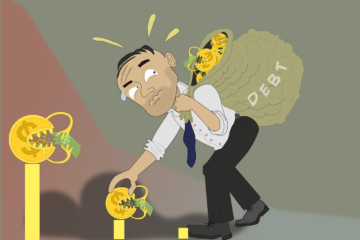One of the most fundamental pieces of money advice that I can give you is the importance of an emergency fund, and more specifically, where to save an emergency fund. Most people think that they have one. But in reality they do not. If you have an “emergency fund” in something like a credit card, HELOC, or other debt product, you don’t really have an emergency fund. Let me show you where you need to keep an emergency fund.
The Purpose of an Emergency Fund
This one is really not up for debate. You WILL have emergencies in your life. You will have a car that breaks down, an unexpected hospital bill, an emergency flight home to see a dying relative, etc.
It will happen.
But in order to be a financially responsible adult, you need to have the money already set aside to pay for such an event.
And you need to have actually SAVED that money.
An emergency fund should not be a credit card, a retirement account, a HELOC, a relative, or any other such product.
An emergency fund should be liquid (meaning that you can access it quickly) and NOT a debt product of any kind.
When you have an emergency, you don’t want to unexpectedly turn that financial problem into an even bigger one.
So where do you save an emergency fund? A savings account at your bank or credit union, a money market account, or cash. Any one of those places are liquid and non-debt products.
The purpose of an emergency fund is to pay for an emergency, not to go further into debt.
How Much Should I Have in My Emergency Fund?
Although financial professionals don’t really disagree as to the importance of an emergency fund, they do sometimes disagree with the amount that should be in the emergency fund.
But here is my guidance.
As a general rule you should have somewhere between 3 months of your expenses and 6 months of your expenses saved in an emergency fund.
This will vary based on your specific situation (I’ll get to that in a minute). But this is general guidance.
And to be clear, it is 3-6 months of your EXPENSES, not income.
So if you add up all of your bills and they are $4,000/month, you need a minimum of $12,000 set aside for emergencies.
If you are pretty risk averse and want to put even more money away than 6 months then that is good also. It will just take some time.
A lot of times I am asked when someone should have an emergency fund size closer to the 3-month amount and when someone should have an emergency fund size closer to the 6 month mark. This article will explain it in more detail.
Where Should I Save My Emergency Fund?
Here is where you should NOT have an emergency fund:
- Credit cards
- HELOCs
- Borrowing from a friend of family member
- A pay advance
- Payday loans
- Title loans
- Retirement Accounts
- Other investments
When you save your emergency fund it should be in a product that you can get your hands on within 24 hours that will not put you into debt and that you do not have to repay.
Here are some options:
- Savings accounts
- Money market accounts
- Cash
That is about it. It’s not sexy. It’s not exciting. But it is safe.
And don’t worry about the interest that you will be making off of your savings. Sure, get as much interest as you can. A high yield savings account is a really good place to put an emergency fund. You can earn 3-5% per year on it (as of April 2023). But don’t get held up on the interest rate. At the end of the day, the interest that you earn from your emergency fund will be miniscule.
Final Thoughts
Having a proper emergency fund is paramount to you succeeding with money.
Having an emergency fund will keep a buffer between your financial health and the unforeseen circumstances that WILL happen in your lifetime.
You would never want to make an emergency even worse by borrowing money from your retirement or a bank to get you through a tough time. You should work to have the money sat aside for when bad things happen to you.
You can do this!
I am here for you!
Until next time!



0 Comments